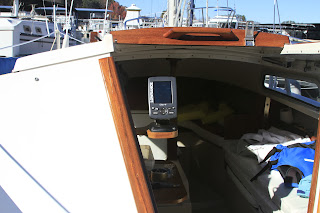
For a while now I been needing to install a depth finder on the boat; with the lake as low as it has been I almost feel like I've been sailing blind out there.
Among other things I been wanting are a compass and a volt meter so I can keep an eye on the state of the battery.
A couple of weeks ago I got a sales brochure from West Marine where they have the Garmin 441s for $369.00; I thought it was not bad considering it has GPS, Depth Finder and a Chart Plotter all in one. I thought it will be nice to have the GPS and Chart Plotter for a few more bucks; by the time I add the Compass, a Depth Finder and the Transducer I'm almost at $300.00, so for a few more bucks the 441s started to look as a good deal.
As it turns out the 441s will not include the transducer (another $80/$100) nor the charts for the lake I sail in (plus another $99) putting the whole thing way out of what I will be willing to spend on it; none the less I decided to go see it at Bass Pro Shop which is closer than West Marine. The guy that worked the electronics counter saw me checking out this unit and asked me if I was sold on it, I replied that I was not, I was just checking it out, he said he had a much better deal depending on the features I was looking for, so I explained to him what I needed, he then pointed me to the Lowrance Elite 4, almost same size screen with a much smaller body, same basic features at a much lower price and inland lake charts and transducer included.
Once he showed me what the Elite 4 does, I saw it was way more than I need, it also has a mode where you can set the screen as a compass. The price... $299.00... I walked out of that store carrying my recently found early Christmas present.


I had to decide weather to install it on the bulkhead or inside on a swinging arm. After considering all the cons of the exterior mounting on the bulkhead it was clear I needed to build a swinging arm for the mount. The interior mounting has several advantages for me; the unit can be used from the inside as well as the cockpit, no need to connect and disconnect the wires to the back of the unit every time you go sailing and it stays out of the way of the many lines that come from over the cabin top.
I installed the transducer in hull, which was exactly what i wanted, I did not want a transom mounted and I did not want to drill the bottom of the boat for a through hull transducer.
I just finished the installation and took the boat out for a test drive, I can say it works very well and I can sail a lot more comfortable now that I know how much water I have beneath the keel.












